
|
|

© A. R. Dean
On April 15th 2011, near Meriden, West Midlands, this Chiffchaff - a standard nominate collybita - gave a so-called 'alternative call' persistently. Every one or two seconds for several minutes it delivered a call with a rising-and-falling pitch, with an abrupt downward inflection. The call could be transcribed as 'sweeoo'. It was one of 14 employing this call observed on that date, with many others heard during April elsewhere in the West Midlands region (90+ during the month). Smaller numbers were still to be heard through May, into the post-migration period, confirming that some individuals were locally breeding nominate collybita (see also 'Mixed pair, call-wise' below).
Such 'alternative' calls are well-known from autumn juveniles but it has often been claimed that they are rarely heard after mid-October (see Article on 'Siberian Chiffchaff'). In fact, 'alternative' calls can also be heard at times in the Winter (see for example Copete & Armada 2004) and on occasions from adults during the breeding season, especially during pair formation. They are 'well-formed' (and sometimes relatively complex) calls and should not be confused with the 'plastic' (and rather variable and hesitant) calls given by very young juveniles which are just learning to call. Experience across Europe shows that, in some years, such 'alternative' calls become dominant in various countries, principally in autumn but occasionally in spring and through the breeding season (e.g. Schwarz 1954, Lindholm 2009, Lindholm 2014, Hoffmann 2010). In a study in Germany in 2009, Hoffmann concluded that individuals using the 'sweeoo' call did so consistently and it reflected individual disposition rather than the transient mood or intention of the caller. However, individuals may well call more frequently at certain stages of the breeding cycle, so those adopting this call will use it with increased prominence at such times (see 'Mixed pair call-wise' below). In Sweden (Magnus Hellström in lit.), a number of individuals using the 'sweeoo' call have been trapped and DNA and stable isotope samples taken, which may clarify their origins, but currently there is no indication that they originate from one particular subspecies or geographical origin. So far data is limited but suggests that instances of numerous 'sweeoo' callers are not synchronized Europe-wide but occur randomly in place and time. No real explanation for this periodic prevalence of an 'alternative' call has been forthcoming but it presumably has some correlation with social interactions or population density. Currently, the UK population of Chiffchaffs is relatively high and on an increasing trend (BTO data). Perhaps a high incidence of the 'sweeoo' call may follow a good breeding season, with a 'critical mass' of first-summer individuals retaining the call into their second calendar-year and this then spreading through the population (e.g. the 'infectious' description applied in BWP to one of the alternative calls - see Footnote)? The occasional 'wayward' or 'eccentric' call is to be expected from Chiffchaffs of all taxa (and other species) but the consistent, regular and widespread adoption of an alternative 'sweeoo' call demonstrates that, like the standard call, the 'sweoo' call is an established call and presumably has some essential cause and biological significance.
From direct correspondence and from on-line discussions, Chiffchaffs using the 'sweeoo' call seem to have been especially numerous throughout the UK during the Spring of 2011, in many areas well-outnumbering individuals giving the traditionally standard, softer, rising 'huit' or 'hweet'.
On April 20th and 22nd, of sixteen Chiffchaffs heard calling at two sites in the West Midlands, twelve gave the 'sweeoo' call and only four the more traditional 'hüit' or 'hweet'. Several individuals were sound-recorded and examples follow.
Downward-inflected 'sweeoo' call (Sonogram: Fig. 1a)
An individual giving a series of 'sweeoo' calls and also a rapidly doubled 'sweeoo-sweeoo' at one point (sounding like 'swee-swee'). (Sonogram: Fig. 2)
A variation of the 'sweeoo' call. The sonograms (Fig. 1b &Fig. 3) show a 'split' or 'sinusoidal' variant comprising two juxtaposed rising components, linked by a falling component, with the second rising section starting from a lower frequency than the first. The frequencies of the two rising components barely overlap, with the pitch of the second significantly lower, so the result suggests a downward inflection to the human ear. Structurally, this sinusoidal variant is a relatively complex call.
For comparison, the traditional, more gentle and rising 'huit' call. (Sonogram: Fig. 1c)
An individual giving a series of 'huit' calls. (Sonogram: Fig. 4)
Below are sonograms of these calls:
|
|
|
|
| (a) | (b) | (c) |
Fig. 1. Sonograms of: (a) downward-inflected 'sweeoo', (b) variant 'sweeoo' and (c) traditional 'huit'.
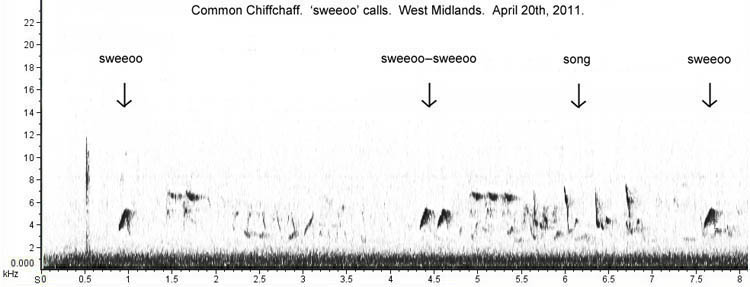
Fig. 2. A series of downward inflected 'sweeoo' calls. Shape is that of an inverted V.
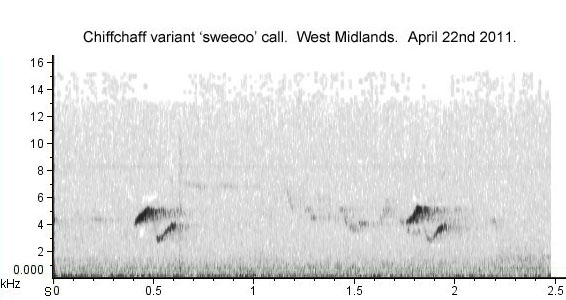
Fig. 3. Variant of the 'sweeoo' call. Comprises
two weakly-linked rising components, with second starting from a lower frequency.
The frequencies of the two rising components barely overlap, so the call still
sounds downward inflected.
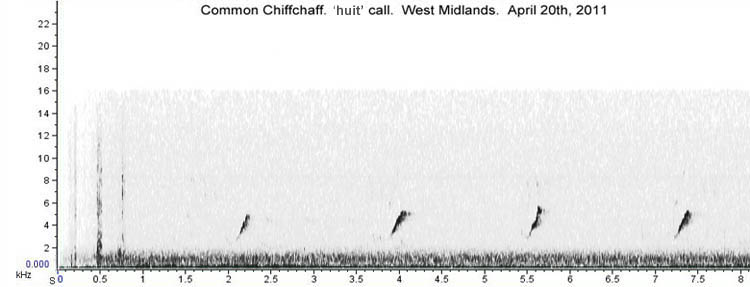
Fig. 4 Traditional, gentle, rising 'huit' call.
In the West Midlands in 2011, adult Chiffchaffs using the fulsome 'sweeoo' or a sharper 'sweeu' version of the call were to be heard in all months from March to July, after which juveniles no doubt contributed to individuals using 'alternative' calls, including somewhat hesitant ('plastic') 'sweeoo' style calls and also a flatter and more tristis-like call. From late May, the total number of adults using the 'sweeoo' call was reduced (presumably as passage came to a close) but from about mid-June, among this reduced population, the number of 'huit' callers began to match or exceed the number of 'sweeoo' callers. Also, among 'sweeoo' callers, a higher incidence of the clipped 'sweeu' version was encountered, though the latter was not invariably sharper than the former. Some individuals swapped between a fulsome 'sweeoo' and a clipped 'sweeu'. From late summer, a rather strident 'hweet' became commonplace. Throughout, with all these non-standard calls, prolonged bouts of persistent calling from Chiffchaffs were widespread and very prevalent, suggesting a relatively high 'population density'.
recording of individual on July 15h 20ll using full 'sweeoo' and clipped 'sweeu' (Sonogram: Fig. 5)
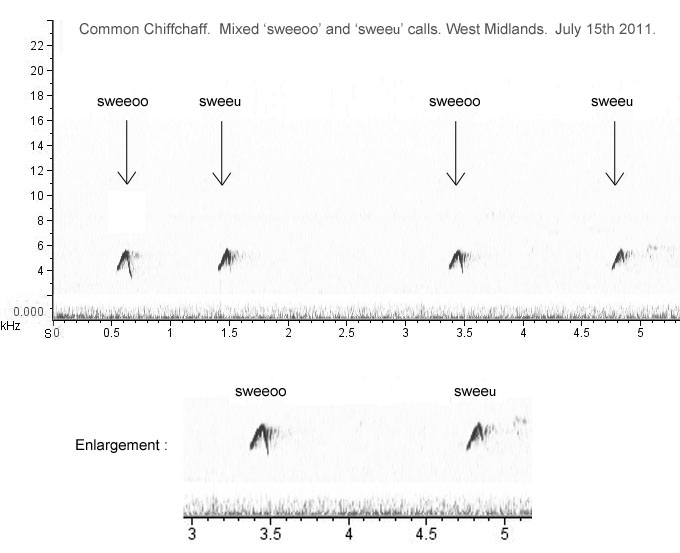
Fig 5. Chiffchaff calling with both full 'sweoo' and slightly clipped 'sweeu'. Note much-truncated descending 'tail' on the 'sweeu' call.

In the study in Germany, Hoffmann (2010) found that the use of different calls by members of a pair was unusual. On July 11th in Warwickshire, two Chiffchaffs were heard in the distance calling to each other, with one using a melodic, rising 'huit' (fairly typical but perhaps slightly longer than average) while the other used the strident, higher-pitched and slightly clipped version of the 'sweeoo' call ('sweeu'). After tracking down the two, they appeared to be a pair, with the 'huit' coming from the male (also heard singing) and the clipped 'sweeu' from the presumed female. In a short space of time the female was seen on three occasions carrying food to assumed nest site or perhaps to unseen and recently fledged young (see photo above). She was apparently able to call in the process, with a brief cessation in calling only at the presumed point of food delivery. Both birds appeared quite settled in their behaviour and the prolonged exchange of calls, which preceded and continued after any visible human presence, perhaps indicated a brood at or near the point of fledging. Calling by females feeding young is known to be frequent, 'especially nearer fledging' (BWP6 / Relations within family group). A 'tending call' (which is apparently rather variable - see Footnote and BWP6 / Voice) is associated primarily with females, which may be related perhaps to the different calls employed by the two individuals.
Extended recording of the call exchange between the two birds
Short extract (Sonogram: Fig. 6)
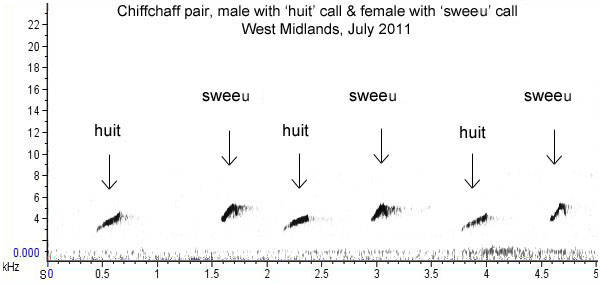
Fig. 6. Apparent pair of Chiffchaffs, with male using 'huit' call and female using 'sweeu' call
As well as the different structure of the calls, note the higher pitch and more strident timbre of the 'sweeu' call.
The repertoire of calls from juveniles in particular is very varied and a given individual may utter a variety of calls. On July 29th 2011 in the West Midlands, a Chiffchaff was recorded giving three very different calls within the space of ten seconds. The third call had more than a hint of Yellow-browed Warbler about it (uploaded in isolation to BirdNET it was diagnosed as that species: Fig. 8).
3 variant calls in a ten-second period from a single Chiffchaff
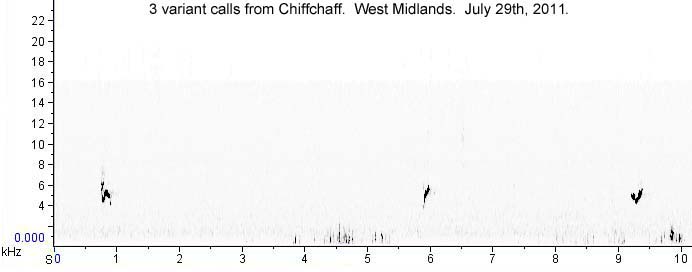
Fig. 7. 3 different variant calls with a ten second period from a single Chiffchaff
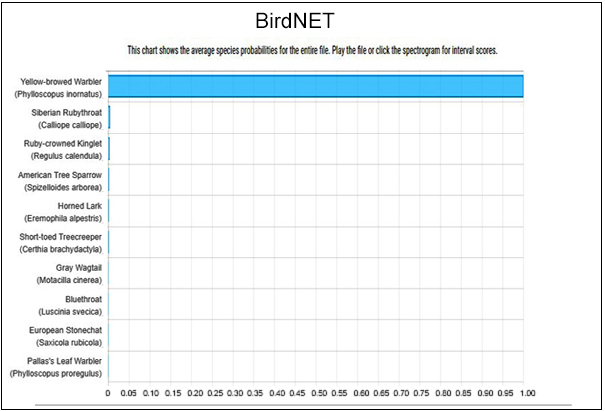
Fig 8. Third variant 'plastic' call of Chiffchaff, sufficiently like Yellow-browed Warbler to be diagnosed as such on BirdNET
The 'sinusoidal' variant has a relatively complex structure, with three distinct elements (respectively rising, falling and then rising again, with the frequency-span of the two rising components barely overlapping - see Fig. 1b & Fig. 3 above and Fig. 9 below). It can be heard in autumn as well as in spring and also occurs across a wide geographical area, having been noted in various studies of alternative calls (e.g. Hoffmann 2010 in Germany and Lindholm 2014 in Finland & Estonia). The main text above includes an example from an adult in spring. For comparison, here ► is an example recorded in Warwickshire in autumn (September 2016). The corresponding sonogram can be seen in Figure 8. Compare this with the spring (April 2011) example and the sonogram in Figure 3. Clearly, these are instances of the same call, involving two different individuals, five years apart and one in spring, the other in autumn. This 'sinusoidal' alternative call would appear to be an integral if infrequent component of the repertoire, probably involving both adults and juveniles, yet its instigation and implications are as yet unknown.

Fig. 9. 'Sinusoidal' variant from an autumn (September) Chiffchaff. Compare with the spring (April) example in Fig. 3.
Postscript: spring & autumn 2017
A further wave of 'sweeoo' calling adults occurred in spring 2017 and was followed by a high incidence of individuals during late summer and autumn, at this season potentially involving juveniles and adults.
In spring, such 'alternative callers' were reported over a wide area, including Holland and Germany as well as the UK. I was abroad during mid-April but indications were that, in Warwickshire and West Midlands metropolitan area, 'sweeoo' callers were fewer than during 2011. Below, in Figure 10, is a sonogram from one I recorded on April 28th 2017 near Bickenhill in West Midlands. It was of the 'sinusoidal' variant described above. This was one of two 'sweeoo' callers I encountered on my first excursion after my return - but these proved to be the only ones I found during April and May, with all other adult Chiffchaffs heard during that period using the standard call. However, a presumed adult at Berkswell, West Midlands, on June 14th was also using a well-formed 'sweeoo' call, again of the 'sinusoidal' variant (Figure 11) while a bird of undetermined age at Netherwood Heath, Warks, on July 12th was using the inverted 'V' variant. An early juvenile on May 18th - with tail still not full-grown - was giving a flat and rather hesitant ('plastic') 'tristis-like' call, as often heard from young individuals in late-summer and autumn.

Fig. 10 . 'Sinusoidal' variant from April 2017.

Fig. 11. 'Sinusoidal' variant from June 2017.
In Worcestershire, numbers were higher and Andy Warr reported at least 25 'sweeoo' callers during April to mid-June. In some areas, above 50% of individuals were using such alternative calls. A high proportion appeared to be paired females. Of 16 which were sound-recorded (including one in Gloucs), seven used the sinusoidal ('Z') vaiant and four the inverted 'V' variant while five used a combination of the two.
Calls of the 'sweeoo' variant were common from late July through August and September, no doubt involving juveniles as well as adults by this stage of the season. In autumn, alternative calls are encountered more-regularly than in spring and it is generally assumed that juveniles are involved predominantly. However, in late summer and autumn 2017, the number of individuals employing the 'sweeoo' variant was much higher than normal : a distinctly higher proportion than at this season in 2011, for example. It seems likely that both adults and juveniles were involved later in the season. During July, August and September I logged a total of 330 bird-days for 'sweeoo'-calling Chiffchaffs in Warwickshire &West Midlands, though there was probably some duplication of individuals at more-regularly visited sites. Around 65% of calling individuals were using the 'sweeoo' call and most which were recorded proved to be giving the 'sinusoidal' variant, though on some the frequency range was narrower and the final 'upstroke' relatively short (e.g. here ► and Fig. 12, especially the third note in the sequence). Such notes were in some ways intermediate between the 'inverted 'V' variant and the sinusoidal (lop-sided 'Z') variant.

Fig. 12. 'Sinusoidal' variant from August 2017. Relatively shallow frequency range and short final upstroke in several notes
Predictably, from early October onwards, Chiffchaffs became relatively scarce in the West Midlands region but among the few observed both standard 'huit' and alternative 'sweeoo' calls were to be heard. As late as November 20th an individual at Coton in Warwickshire was using the 'sweeoo' call while in Worcestershire a small influx of eight Chiffchaffs at Ripple over the weekend of November 18th / 19th involved seven using the 'sweeoo' call (per Andy Warr). Thus, during 2017, 'sweeoo' callers were to be heard in all months from April through to November (at least).
Footnote: The section on ‘Voice’ in the account on Common Chiffchaff in BWP6 provides extensive commentary on calls, with calls grouped according to their perceived functions. It is acknowledged that several transcriptions may refer to the same call and that there is also some uncertainty into which group certain calls should be placed. However, contact and alarm calls (group 3) are divided into three types. Renditions under 3a include notes which can be equated with the ‘huit’ call and the ‘sweeoo’ call, with the latter described as:
' ... mainly a long-retained juvenile call but also given by adults (in certain years and places) on breeding grounds (Schwarz 1954a, b)'.
Thereafter, call 3b, designated as ‘Tending-call’, is transcribed as:
' .. a short ‘füt’ .. given mainly by females (very rarely by males) as contact call with dependent young’,
with the comment:
‘In some females difficult to distinguish from hweet call in others easy (Homann 1960)’.
Finally, call 3c, designated as an alarm call is transcribed as:
‘.. sharp, loud ‘fiet’ given by both sexes when disturbed, also spontaneously in autumn, when infectious (Homann 1960; Homann & Gwinner 1963; Radford 1989).’
Unfortunately, there are no sonograms for 3b and 3c while the comment for 3b implies a rather wide compass! Hence, it is difficult to interpret these call descriptions precisely, how they may fit into the spectrum of so-called 'alternative calls' or whether either 3b or 3c could have similarities to a clipped or truncated ‘sweeoo’ call. However, as the ‘sweeoo’ call is traditionally associated with juveniles, it is tempting to think that it may have some derivation from an adult ‘contact call with dependent young’ and/or an ‘alarm call which is also given spontaneously in autumn, when infectious’.
Acknowledgement
Thanks to Andy Warr for data from Worcestershire.
|
|